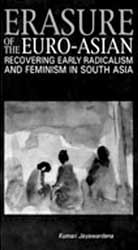
Giving a maligned community a place in historyErasure of the Euro-Asian: Recovering Early Radicalism and Feminism in South Asia by Kumari Jayawardena. Reviewed by Chandra R. de Silva Kumari Jayawardena has once again produced a readable volume that brings her incisive intellect to bear on the historic role of a community that she terms Euro-Asian (the product of unions between South Asians and Europeans). Using her perspectives on ethnicity, gender and class and accumulating a great deal of data for the nineteenth and twentieth century, she argues for the centrality of the historical role of Euro-Asians, thus challenging the existing perspective which emphasizes their marginality in South Asian history. She points out that many Euro-Asians of the time were children of the Enlightenment and had a vision of a more democratic and egalitarian society. While assailing the prejudices that have contributed to their virtual ‘erasure’ from history, she is also careful in recognizing the divisions and struggles within the group. The result is a book that should attract general readers while providing a fresh perspective to professional historians.
The author is one of South Asia’s prominent Social Scientists. Her 1972 book on The Rise of the Labour Movement in Ceylon (Duke University Press) established her reputation but it was her Feminism and Nationalism in the Third World (Zed Books, 1986) that brought her truly international repute. That text is still used in colleges and universities and she has followed it up with other excellent monographs, The White Woman's Other Burden: Western Women and South Asia during British Rule (Routledge, 1995) and From Nobodies to Somebodies: The Rise of the Bourgeoisie in Sri Lanka (Social Scientists' Association, 1998). Each of these works made significant contributions to historiography and her work on Erasure of the Euro-Asian is no different. The author coins the term Euro-Asian to cover the communities known as Ango- Indian or Eurasian in the Indian subcontinent and Burghers in Sri Lanka. This seems to be part of her project to rescue this community from the stereotypes and prejudices that have been associated with these terms. Kumari Jayawardena clearly shows how both the Europeans and the local communities were hostile to ‘mixing’ and argues that, as a consequence, Euro-Asians had to continually combat prejudices and stereotypes. The community itself was both stratified (due to class and colour differences within it) and fluid (because disrupting the norm opened up new possibilities). Despite the relative lack of evidence for the period before the late eighteenth century, the author pays some attention to the early evolution of the community. However, the strength of the book is in its treatment of the nineteenth and early twentieth centuries. Here the author connects events and developments in Europe to the evolution of the community in South Asia. Kumari Jayawardena uses the case of Henry Louis Vivian Derozio (1809-31) to illustrate the significant role played by Euro-Asians in the nationalist movement in Bengal. She is even more convincing when she recounts the roles played by Euro-Asians such as Richard Morgan (1821-76) and Charles Ambrose Lorenz (1829-71) in Sri Lanka’s history. While it is true that many Euro-Asians became less critical of British rule and less politically active after the growth of nationalist movements, the author’s call for more attention to the role of Euro-Asians is certainly justified. Kumari Jayawardena also points out that Euro-Asians played a key role in early labour movements. Very few of us recall that in 1893 nine of the ten committee members of the Public Service Mutual Provident Association in Sri Lanka were Euro-Asians. She also provides ample evidence that Euro-Asians played pioneering roles in securing entry for women into the professions. Equally significantly, Kumari Jayawardena touches (though she does not elaborate) on instances where perceptions of Asian and Eurasian women influenced British perceptions of themselves. Every good book points towards the need for further work. The Erasure of the Euro-Asian is stronger in terms of data on Sri Lanka than for the rest of the Indian sub-continent. There were some 300,000 Euro-Asians in India in 1947 but only a sixth of that number of Euro-Asians lived in Sri Lanka. These figures point to opportunities for further work on the communities in India, and perhaps in Pakistan and Bangladesh. Then again, while the author has used all published data on Sri Lanka, the gap encompassing most of the eighteenth century in the book also suggests that we need a social history of Sri Lanka for that century, a social history that utilizes extensive material available in Dutch archives. Those who are interested in the saga of Euro-Asians should perhaps also seek out the many writings of Gloria Jean Moore whose 1986 book The Anglo-Indian Vision (AE Press, Melbourne) also claimed that Euro-Asians were pioneers whose achievements were devalued through prejudice. While Dr. Moore’s writings are not as scholarly as those of Kumari Jayawardena they do provide more information on the community in the Indian subcontinent. The subsequent history of the Euro-Asian community, now half a million strong and living mainly in South Asia, Britain, Canada and Australia can be traced through issues of the International Journal of Anglo-Indian Studies and also through accounts of reunions posted on the Internet. This is a community that will surely find Kumari Jayawardena’s account fascinating and the book should be marketed so that it comes to their attention. The reviewer is Professor of History and Dean, College of Arts and Letters, Old Dominion University, Norfolk, Virginia |
|| Front
Page | News | Editorial | Columns | Sports | Plus | Financial
Times | International | Mirror | TV
Times | Funday
Times || |
| |
Reproduction of articles permitted when used without any alterations to contents and the source. |
© Copyright
2007 | Wijeya
Newspapers Ltd.Colombo. Sri Lanka. All Rights Reserved. |
